Solving Sealing Challenges
USER GUIDANCE ABOUT EXPLOSIVE DECOMPRESSION AND OTHER O-RING RELATED ISSUES FOR TURBOMACHINERY SERVICE
Equipment and devices that are used to generate or control fluid pressure all require their contents to be contained or allowed to flow through defined regions. Sealing devices that ensure interfaces between adjacent parts cannot allow the pressurized fluid to escape. These seals have to adopt many different forms using a variety of materials. In the case of turbomachinery, seals typically have irregular shapes and have to accommodate tight tolerances. Hence elastomeric components are often employed.
One of the most widely adopted forms for elastomeric sealing devices is a circular cross-section chord that is produced in a solid annular ring format commonly referred to as the O-ring (Figure 1). The Oring has a circular cross section that can also be pressed into irregular profiles.
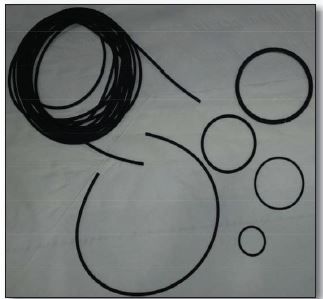
Figure 1: Circular cross-section chord,
known as the O-ring[/caption]
To work correctly, an O-ring has a certain amount of compression applied to its circular section (usually between 15- 20% for static applications; however, it can be as low as 1% and as high as 30%). The initial compression provides a contact load on the surrounding housing and acts as the preload sealing force.
The elastomeric material is incompressible at normal working temperatures and this enables it to deform as fluid pressure is applied to it. Pressure deforms the O-ring, which creates an interference stress between the seal and the groove that is always equal to the applied pressure plus the initial interference or preload stress.
If the initial interference stress is maintained, the O-ring can function as a sealing device over a range of pressures and temperatures. O-ring failure is generally a consequence of the initial force being lost. This is often caused by movement of the surrounding parts (i.e., distortion), extrusion of the Oring or a change in the properties of the elastomer itself due to chemical attack, swelling, shrinkage or aging effects.
Because the O-ring continuously deforms under the action of pressure, the groove into which it is fitted acts as a constraint and support for the O-ring. In general terms, the cross-sectional area of the rectangular groove tends to be about 15% larger than the maximum cross section of the O-ring under ambient conditions.
However, the coefficient of thermal expansion of elastomers is far greater than that of most other engineering materials (e.g., steel) so the additional groove volume is necessary to accommodate any increase in temperature or expansion of the O-ring.
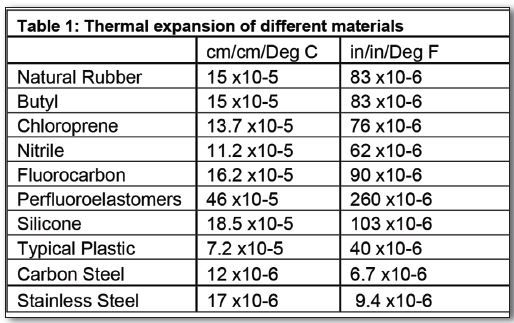
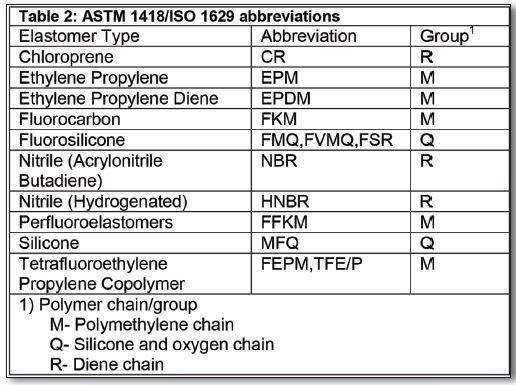
Table 1 highlights the amount of expansion normally experienced by various materials. There are many material types used for elastomers that are usually categorized into standard groups that identify the base materials whereby several characteristics are common to elastomeric materials (Table 2).
Most elastomers consist of a long chain of molecules that contain a repeating monomer (a molecule that can be bonded to other identical molecules to form a polymer) pattern. These long chains give elastomers the ability to stretch to many times their original length. Polymer chains on their own are relatively weak, so these chains need to be crosslinked to increase strength via curing agents added to the base material.
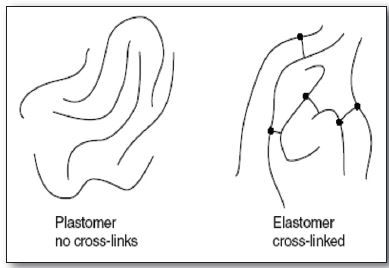
Figure 2: The base material (left) is shown prior to processing. Crosslinking (right) provides improved properties[/caption]
Other substances can be added to change material properties such as fillers and processing aids (Figure 2). Molding techniques, temperature, time and power consumption also influence elastomer properties. Probably the most common elastomeric sealing material used in the oil and gas turbomachinery industry is the fluorine-based fluoroelastomer (FKM).
Explosive decompression
Explosive decompression (ED) occurs to elastomers when gases are absorbed into the material through pressure and retained within the material until the system is depressurized. These retained gases expand rapidly causing blistering and mechanical damage (Figure 3). The extent is dependent upon factors such as sealed pressure, decompression rate, the gas itself and material properties. ED, also known as rapid gas decompression (RGD), is largely related to material tear strength.
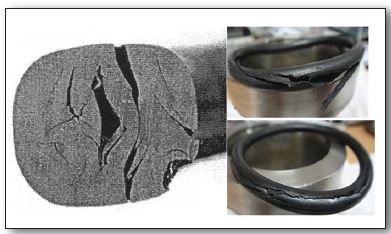
Figure 3: Typical ED damage internal (left) and external (right)[/caption]
This dictates the ability to resist cracks from regions that are highly stressed during decompression. Pockets of trapped gas induce stress within the material void. Elastomers with high tensile strength and high tear strength tend to resist such damage more readily. However, this comes at the expense of flexibility and resilience.
Explosive decompression is the most important material characteristic when specifying elastomers for high-pressure gas duty. Many organizations have developed their own ED assessment and test procedures. However, such testing has limitations. Exposure time to high pressure, for example, influences how much gas permeates into the material.
Similarly, the number of pressurization and depressurization cycles impacts the amount of damage. Additionally, factors such as the gas used in testing, the size of the O-ring and the way it is mounted all have an impact on the material being tested.
It is also important to realize that these tests do not assess the specimen’s ability to seal effectively. In ED tests, the O-ring is pressurized from both sides, whereas in service an O-ring is used to separate a highpressure medium from a low-pressure medium (i.e., pressure is only applied to one side of the sealing device).
In fact, the damage-rating system is based on a numerical ranking from 0 to 5. The rating scores the condition of the material contained within a cut section where four cuts are usually done per specimen. The position of the cut and the manner in which the material is divided alter results. A 4 or 5 grade signifies failure, however there is significant damage to O-rings with a 3 rating (Table 3 and Figure 4).

Table 3: Characteristics common to elastomers[/caption]

Figure 4: Retained gases expand rapidly causing blistering and mechanical damage[/caption]
As there are several international standards (Norsok M-710, ISO 23936) and independent standards (Total GS PVV 142, Shell DODEP 02.01B.03.02) that cover ED testing using a number of test parameters and variables associated with ED resistance, it is best to conduct more detailed evaluations when choosing elastomers for high-pressure duties in turbomachinery.
Therefore, make sure that the full gas composition is known (together with any variations), identify all known operating conditions (not just minimums and maximums), and make sure that pressure and temperatures are correctly paired for cyclic duties.
Further pointers: At sub-zero temperatures elastomers are brittle; at elevated temperatures the elastic strength of elastomers is reduced; the explosive decompression potential becomes significant for service pressures of about 40 bar (580 psi) or higher.
If ED is suspected, an assessment should be made to determine under what conditions and at what rate the sealed system can decompress; and in conditions where pressure differential is high, damage can occur to elastomer seals after just one single decompression cycle.
Actual seal failure is most likely to become evident following start-up after a damaging system depressurization. It is vital, then, to monitor equipment carefully on each start-up to look for anomalies that could indicate a seal failure. However, proper design, operation and preventative maintenance make it possible to avoid explosive decompression.
Written by:
